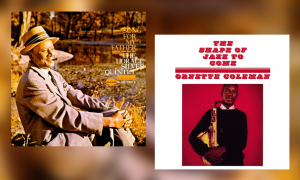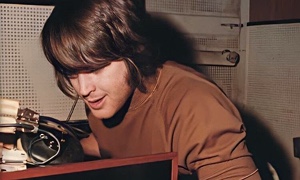Home » Jazz Articles » Building a Jazz Library » Zakir Hussain: The Best Jazz / Crossover Albums
Zakir Hussain: The Best Jazz / Crossover Albums

Courtesy Nedici Dragoslav
Since the 1970s, Hussain has been at the forefront of so-called World Music, experimenting with Indo-rock in Shanti, pioneering pan-global rhythms alongside The Grateful Dead's Mickey Hart, and forging an unprecedented path with John McLaughlin's groundbreaking Shakti. Hussain has collaborated with Pharoah Sanders, Pat Martino, Charles Lloyd, Joe Henderson, Dave Holland, Chris Potter, Jan Garbarek and George Brooks, but these high-profile associations only hint at the diversity of Hussain's output.
In celebration of Hussain's milestone, the following list is a guide to some of the great tabla player's most notable collaborations in the fields of jazz and crossover experimentation of the past fifty years.
 Shanti
ShantiShanti
(Atlantic)
1971
Thanks largely to The Beatles' embrace of Ravi Shankar—and the latter's phenomenal global success—Indian music was all the rage in the 1960s, inspiring several bands more rooted in jazz and rock to experiment with Indian classical music. Shortly after arriving in America in 1970, Zakir Hussain joined Shanti, an Indo-rock fusion group featuring sarod player Aashish Khan, fellow tablaist Pranesh Khan, lead guitarist Neil Seidel, vocalist/guitarist Steve Haehl, electric bassist Steve Leach and drummer Frank Lupica. The short-lived band's only recording was produced by Richard Bock, who had previously worked with Ravi Shankar.
Shanti is an enjoyable if somewhat patchy affair. The Indian instrumentation is all but relegated on the five tracks written by the American musicians, which reflect the country-rock influences of Crosby, Stills & Nash, and Grateful Dead. Equally, the two numbers composed by Aashish Khan, of which the ten-minute "Innocence" is by far the stand out track, show an imbalance the other way. Drums and Indian percussion trade licks on "Shanti" but such dialog is rare. Aashish Khan, an undoubted virtuoso, is the star of the show with some wonderful playing, where permitted. Incidentally, Leach would find fame thirty-five years later as Seasick Steve.
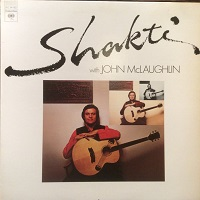 Shakti
ShaktiShakti: With John McLaughlin
Columbia
1976
After the burn out and dissolution of the Mahavishnu Orchestra, English guitarist John McLaughlin surprised everyone in 1973 with the launch of Shakti. This all-acoustic group was groundbreaking in its fusion of northern Hindustani and southern Carnatic traditions, spiced up by McLaughlin's jazz-leaning fireworks. McLaughlin was joined by violinist L. Shankar, mridangam player Ramnad Raghavan, ghatam/mridangam player T.H. Vinayakram and Zakir Hussain on tabla, the latter whom Mclaughlin had met and befriended following a Mahavishnu Orchestra performance in 1971.
Shakti recorded three outstanding albums, but his live recording from a 1975 concert at Southampton College, Long Island captures the incredible energy of the band better than the two studio albums that followed. The band explodes out of the blocks with "Joy," an exhilarating eighteen-minute thrill ride of riveting high-speed unison play between McLaughlin and L. Shankar, breathless extended solos and impassioned rhythms.
The truncated "Lotus Feet" reveals a more tender and intimate side of Shakti, but the fade out, just as percussion enters, is annoying. That disappointment is soon forgotten by the epic "What Need Have I For This, What Need Have I for That-I am Dancing at the Feet of my Lord-All is Bliss, All is Bliss." From its drone intro to its riveting percussion finale nearly half an hour later, the music builds slowly but inexorably through a series of ecstatic peaks. Tension and release, individual fire and surging collective waves bring the crowd's enthusiasm to the boil. A wonderful performance culminates in a lengthy call-and-response between Hussain, Raghavan and Vinayakram, followed by a powerful unison adieu from all five musicians. Essential listening.
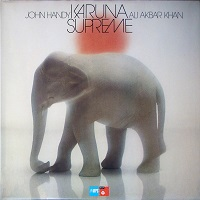 John Handy & Ali Akbar Khan
John Handy & Ali Akbar KhanKaruna Supreme
MPS
1976
Alto saxophonist John Handy made his name in the late '50s groups of Charles Mingus, though for most of his career he was a leader in his own right. This Joachim Ernst Berendt-produced recording finds Handy engaging in extended, raga-type dialog with the great sarod player Ali Akbar Khan, with Zakir Hussain accompanying on tabla. The twenty-minute long "Ganesha's Jubilee Dance" is the standout track. Yogish S. Sahota maintains a tanpura drone throughout while Handy and Khan trade back and forth. Hussain is perfectly attuned to the improvised exchanges, led by Khan, which build to a dramatic crescendo.
On the jaunty title track Handy and Khan improvise in turn, returning time and again to a delightful unison melody that lingers long in the memory. Hussain's energized performance, however, is central to the character of the composition. By contrast, the lyrical "The Soul and the Atma" is a slower, more introspective meditation, though once again colored by tanpura drone and percolating tabla.
Essentially Indian classical music featuring alto saxophone rather than a true Indo-jazz fusion, Karuna Supreme is still a beautiful recording, and one that foreshadows the more successful coming together of Indian classical and jazz musicians on the ECM label that Hussain was central to a decade later.
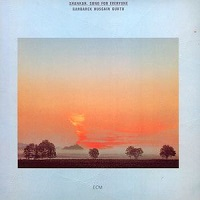 Shankar
ShankarSong for Everyone
ECM
1985
Song for Everyone is the second of two albums that Hussain recorded with violinist L. Shankar post-Shakti. The first, Who's to Know (ECM, 1980), an outstanding set of traditional ragas, is arguably one of the finest of the many Indian classical recordings that Hussain has made. Four years later, Hussain was back with L. Shankar for Song for Everyone, a successful crossover recording featuring Jan Garbarek, with additional percussion courtesy of Trilok Gurtu.
Hussain is fairly subdued throughout, playing a purely accompanying role to Shankar and Garbarek, the undoubted stars of the show. Violinist and saxophonist shine on these highly melodious tunes, of which the title track is particularly pretty. Hussain plays congas on "Paper Nut" but switches to tabla—to much greater effect—on "I Know" and "Conversation." Inexplicably, given the presence of two of the world's greatest percussionists, several tracks feature a drum machine, which sounds not only terribly dated from today's stance, but ill-conceived from the get-go. Still, there is much beauty to be enjoyed here in songs of pronounced lyricism.
It's worthwhile digging a little into Shankar's extraordinarily diverse discography. Prior to Shakti the violinist had recorded with Archie Shepp and krautrock legends Amon Düül II; in the years after, Shankar crops up in some surprising places, including recordings with Frank Zappa, Talking Heads, Marianne Faithful, Ginger Baker, Public Image Ltd., Swans, Yoko Ono, Maurice Jarre, and repeatedly with Peter Gabriel.
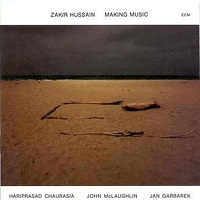 Zakir Hussain
Zakir HussainMaking Music
ECM
1987
One of the truly great East-meets-West recordings, the all-acoustic Making Music is an undoubted gem in Hussain's discography as leader. Hussain, Jan Garbarek, John McLaughlin and Hariprasad Chaurasia combine brilliantly on compositions of striking beauty. There are no fillers here, and the twelve-and-a-half-minute title track, which features stunning solos from McLaughlin and Garbarek, and an exciting exchange between Hussain and Chaurasia, is perhaps the main highlight.
The expectation might be for some real sparks from these musicians, and they certainly deliver on that score, but it is the balance struck between virtuosity and delicate lyricism that makes this album so enchanting. The McLaughlin-penned "Zakir" ticks both those boxes, with an achingly pretty solo from Chaurasia and a powerfully keening response from Garbarek giving way to a fine intervention from the leader. It is no surprise that Hussain features more on this record than he does on some of his sideman appearances, though it is notable just how much room he leaves for the other musicians.
Hussain impresses with a solo spot and a dash of konnakol on "Anisa" and rekindles the Shakti flames of a decade before with his old sparring partner McLaughlin on the fesity duet "You and Me." But the music is most seductive when all four musicians dovetail, as they do splendidly on the graceful slow burner "Sunjog." The only slight niggle about an otherwise close-to-perfect album is the fade out on closing track "Sabah"—a brooding, Mahavishnu Orchestra-esque miniature—just when the quartet seems poised to take off. Still, a joy from start...almost to finish.
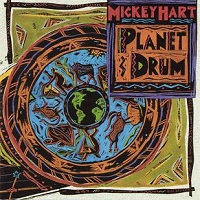 Mickey Hart
Mickey HartPlanet Drum
Rykodisc
1991
Zakir Hussain has enjoyed a long association with The Grateful Dead's Mickey Hart, laying down the rhythm tracks on the drummer's first solo album, Rolling Thunder (Warner Bros, 1972), two of which are trio numbers with Hart and Jerry Garcia. Hart joined Hussain's Tal Vadya Rhythm Band in 1973, which morphed into the co-led Diga Rhythm Band. Its album Diga (Round Records, 1976) was something of a landmark in fusing global rhythms. Fast forward fifteen years to Planet Drum, an ambitious, international rhythm project that enjoyed significant commercial success.
Joining Hart and Hussain are legends such as Babatunde Olatunji, Sikiru Adepoju, Giovanni Hidalgo, Airto Moreira, Flora Purim and Hussain's former Shakti colleague T.H. Vinayakram, amongst others. Hussain features on half the tracks. Musically, the shifting ensembles embrace African chant rhythms, ritual mantras where berimbau, tabla and talking drums fuse, and ambient grooves that are closer to chill out terrain.
This surprisingly relaxed album only occasionally lives up to its all-star billing, but still sold close to a million copies and scooped a Grammy Award for Best World Music Album. Exerts a subtly hypnotic charm.
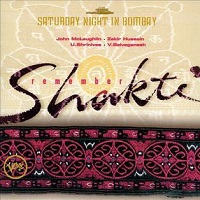 Remember Shakti
Remember ShaktiSaturday Night in Bombay
Verve
2001
Shakti disbanded in 1978, and bar a brief tour of India in 1982, it would remain inactive until a relaunch—and rebrand—in 1997. Remember Shakti, as the new incarnation was called, saw McLaughlin—now on electric guitar—Zakir Hussain and VIkku Vinayakram reunite, but without L. Shankar. Three live albums in as many years featured a number of musicians come and go, notably Hariprasad Chaurasia, who made such an indelible mark on the lyrical Remember Shakti (Verve, 1999).
For this concert recording, Remember Shakti comprised McLaughlin, Hussain, kanjira maestro Vikku Selvagnaesh and electric mandolinist U. Srinivas. This heavyweight line-up was augmented by a number of special guests, including six percussionists. Vocalist Shankar Mahadeven matches the rapid-fire lines of McLaughlin, Srinivas and Hindustani slide guitarist Debashish Bhattacharya on the explosive "Luki," but also proves himself to be a seductive balladeer on the exquisite "Giriaj Sudha," which blossoms from a meditative beginning into a celebratory, ensemble tour de force.
The twenty-six-minute-long masterpiece "Shringar," constructed around the dreamy, zither-like santoor of Shivkumar Sharma, casts a trance-like spell before McLaughlin and Hussain combine in a mesmerizing dialog of real intensity. Likewise, "Bell' alla" grows from drone and feathery arpeggios, via unison melodic passages, to extended solos from Bhattacharya and McLaughlin, spurred on by the percussive agility of Hussain and Sivamani. The contrasts between patient build and explosive bursts, between individual adventure and thrilling unison play, make this a hugely rewarding listening experience.
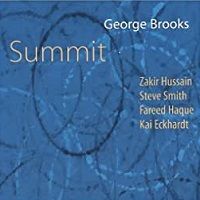 George Brooks
George BrooksSummit
Earth Brother Music
2002
In the late '90s Hussain recorded with Pat Martino on Fire Dance (Mythos Records, 1998), with Pharoah Sanders on Save Our Children (Verve, 1999), and on the underrated Anthony Hindson's It's a Curious Life (1999)—a lively fusion of jazz, rock and raga also featuring Tony Williams, Jack Bruce, Scott Thunes, Shankar and T.H. Vinayakram. Hussain also recorded three excellent albums with saxophonist George Brooks, of which Summit is arguably the strongest.
Featuring a powerful rhythm section of Steve Smith, Kai Eckhardt and Hussain, the distinctive, gnarly guitar work of Fareed Haque, percussionist Taufiq Qureshi (Hussain's younger brother) and a guest appearance from rising sitar star Niladri Kumar, Brooks' compositions—sophisticated yet visceral—successfully corralled these potent individual talents to powerful effect. The leader shines on tenor and soprano saxophones, but as with the best groups, it is the collective voice that holds sway.
On a consistently strong album, the elegant "Waltz for Lena," the bustling jazz-fusion of "FrameMaster (Puriya Daneshri)"—where Hussain feeds Haque's fire on acoustic guitar—and "Stitching Time," with the brilliant guitarist in sizzling form on electric—are all standouts. Hussain is an animated presence throughout on a splendid group effort.
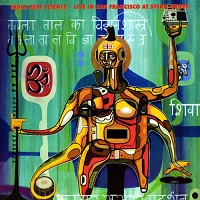 Tabla Beat Science
Tabla Beat ScienceLive In San Francisco at Stern Grove
Palm Pictures
2002
In 1999, bassist/producer Bill Laswell and Zakir Hussain assembled Tabla Beat Science, uniting tabla aces Trilok Gurtu, Talvin Singh and Karsh Kale with sarangi maestro Ustad Sultan Khan. Add a turntable and a dash of electronics to the mix and what emerged on its debut, Tabla Matrix (Axiom/Palm, 2000), was an intoxicating and broadly uncategorizable fusion of Indian classical music, ambient, drum 'n' bass and electronica.
This live recording, with a different formation—and minus Gurtu and Sing—fizzes with an even greater energy, fuelled by the energy of the 10,000-plus crowd at Stern Grove, San Francisco. Hussain and Sultan Khan are compelling on the epic "Taaruf," an unadulterated classical exposition. Laswell's deep bass groove leaves a deep imprint on much of the rest of the music, with DJ Disk on turntables, Midival Punditz on electronics and Fabian Alsultany on synthesizer adding a range of urban textures on the trippy "Ap Ke Baras," with its rave-like intensity, on the dub-fuelled sarangi-cum-tabla joust of "Magnetic Dub," and on the drum 'n' bass-heavy "Tala Matrix."
A strong improvisatory spirit pervades these encounters, with Kale—on drums—and Hussain creating a frenetic rhythmic churn on "Sacred Channel," while Sultan Khan and Ethiopian singer Gigi's soaring vocal call-and-response lies at the heart of "Nafeken," "Satellite (Show Me the Worth of the World)" and the fourteen-minute opus "Magdalena." Positively unrelenting for over ninety minutes, and with Hussain well to the fore, Tabla Matrix is a heady delight.
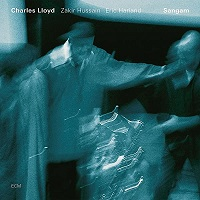 Charles Lloyd
Charles LloydSangam
ECM
2006
Charles Lloyd's first live album for the ECM label, recorded at the saxophonist's beloved Lobero Theatre in Santa Barbara, sees the saxophonist, Eric Harland—his regular drummer—and Hussain form an intuitive trio that responds on the fly to each other's prompts in these largely improvised contexts. Lloyd had long been interested in Indian music, culminating in Geeta (A&M, 1973), whose Indian-inspired suite featured Pranesh Khan and Aashish Khan, both of whom had played with Hussain in Shanti.
The influence of ragas on Lloyd's concept is felt, but more prominent is the influence of John Coltrane, particularly on the lively "Tales of Rumi," where free improvisation reins, albeit a freedom colored by Lloyd's melodic bent; the rhythm team raises some steam, with Hussain accentuating the melodic reach of the tabla with a brief quote from the Rossini-inspired theme to "The Lone Ranger." The trio is at its best on the longer, overtly modal jazz-informed pieces, such as "Dancing on One Foot" and "Hymn to the Mother," where the freedom and harmonic sophistication central to this trio's workings shines forth.
Lloyd makes a heartfelt stab at Indian-style vocals, a kind of yearning bhajan, (devotional song) on Hussain's meditative composition "Guman," where the leader also takes an extremely rare turn on the piano. East and West fuse to stronger effect on the gently grooving "Little Peace," where Lloyd's bluesy flute rides the waves of Hussain and Harland's keenly felt exchanges.
That Sangam is still the only recording from this still active trio probably attests to its improvising ethos, which is generally better suited to the stage than the studio.
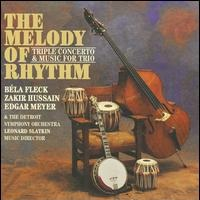 Béla Fleck/Edgar Meyer/Zakir Hussain & The Detroit Symphony Orchestra
Béla Fleck/Edgar Meyer/Zakir Hussain & The Detroit Symphony OrchestraThe Melody of Rhythm
Koch
2009
What do Béla Fleck, Edgar Meyer and Zakir Hussain have in common? Quite a lot, it transpires. Grammy winners all, each has composed or premiered classical concertos, and more significantly, perhaps, all three have always been open to experiments in new musical fields. Fleck and Meyer had long worked together as a duo, but the addition of Hussain not only brings additional rhythmic drive, but a pronounced Indian aesthetic to boot. There are six trio pieces, and three with the Detroit Symphony Orchestra, steered by the renowned American conductor Leonard Slatkin.
The chemistry between the three is palpable, particularly on the fast-paced "Out of The Blue," but this is a trio that compels at any tempo. Meyer switches between plucked and arco duties with aplomb, his soloing—for the most part with bow in hand—is a lyrical delight. Fleck's bluegrass-cum-jazz virtuosity is staggering. On compositions like "Bubbles" and "Cadence" sitar and sarangi could easily have replaced Fleck's banjo and Meyer's arco playing, so steeped are the lively exchanges in Indian classical tradition.
The heart of the record, however, is the title track, a three-part suite for trio and symphony orchestra. An exotic marriage of Western classical, Indian classical and folkloric idiom, the twenty-eight-minute-long suite is a rollercoaster ride of oscillating tempi, high-paced unison drama and seductive slower passages. Melody and rhythm, needless to say, are the constant driving forces. Impressive too, the balance struck between nuanced orchestral accompaniment to the trio's exhilarating interplay and orchestral protagonism. An imaginative project that comes off brilliantly, and one of Hussain's strongest collaborations.
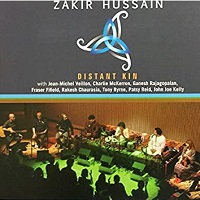 Zakir Hussain
Zakir HussainDistant Kin
Moment Records
2015
Invited to the aptly named Celtic Connections festival in Glasgow, with the aim of lining up Indian classical musicians alongside Scottish folk musicians, Hussain had history—and insider knowledge—on his side. For the guts of a century under the direct rule of the British Raj, Indian musicians were commonplace in British military bands, replete as they also were with Scottish, Welsh and Irish musicians. Flutes, frame drums and bass drums were common to both Celtic and Indian traditions, and Hussain grew up hearing this intertwined legacy in the processional/festival bands near his home in Mahim, Mumbai.
No surprise then, that the musical connections here feel so organic, though Hussain deserves plaudits for juxtaposing instruments of similar tonalities. On the medley "Trinkamp/Tajir," it's the wooden flute of Breton musician Jean-Michelle Veillon and the bamboo equivalent of Rakesh Chaurasia, and Hussain's tabla and John Joe Kelly's bodhrán that dissolve the geographical borders. On "Celnataka," the symmetry between the violin of Remember Shakti's Ganesh Rajagopalan and the Scottish fiddles of Charlie McKerron and Patsy Reid is foregrounded.
There's zest in the nine-piece ensemble's spirited "Jig O' Beer and Chai," where bagpipes and martial drums tip a wink to historical ties between Britain and India, and pastoral reverie in the ballad "The Baby Tune." Other highlights include the grooving flute fest that is "Michael's Matches/Rakesh's Bansi," and fascinating reworkings of Hussain's compositions "Watergirl"—which features a jaw-dropping tabla solo—and "Making Music," with guitarist Tony Byrne's folksy intro and a lively reel outro bookending this melodic gem. Distant kin? Not so distant after all. Wonderful stuff.
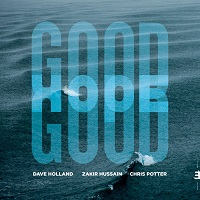 Dave Holland/Zakir Hussain/Chris Potter
Dave Holland/Zakir Hussain/Chris PotterGood Hope
Edition Records
2019
These three musicians first came together at the behest of Hussain, who had assembled a septet version of the Crosscurrents ensemble for a SF Jazz project in 2017. After a couple of tours, the ensemble was whittled down to its current trio form, touring widely in the summer of 2018. Good Hope, however, sounds like the work of a group who have been around for much longer.
Potter is in scintillating form on tenor and soprano saxophones, his melodic lines swinging between sing-song accessibility and highly charged flurries. Holland, in masterly fashion, weaves independent yet complimentary bass paths, and provides the fulcrum between Potter and Hussain. The tablaist juggles groove-based comping and probing bursts that ask as many questions of the saxophonist as they answer. Unlike many of Hussain's other collaborations, however, Crosscurrents is not a raga-based, Indo-jazz fusion project, but rather a meeting of like-minded musicians, intent on listening to each other's highly distinctive voices.
From the opener "Ziandi," the music is unfailingly upbeat. A sunny vibe permeates the Caribbean-inspired "Island Feeling," while slower tunes like "Suvarna" and the evocative, Middle Eastern-tinged "Bedouin Trail"—with a gorgeous bass ostinato—are gently uplifting. Potter switches to soprano saxophone on "Lucky Seven"—reimagined from Holland's Critical Mass (Dare2/Sunnyside, 2006)—and engages Hussain in fesity discourse. The two produce another memorable encounter on "Good Hope," with Potter reverting to bustling tenor mode. Hussain broadens his own tonal and rhythmic palette with judicious use of kanjira, chanda and madal.
Hussain demonstrates his melodic sensibility on the self-penned "J Bhai," his tribute to John McLaughlin, which features solos of contrasting character: Holland, with a beautifully weighted improvisation full of space, and Potter in ebullient form on tenor, pave the way for Hussain, whose rattling solo over a bass-cum-saxophone vamp provides a stirring finale. The trio saves the best for last, with a stunning rendition of "Mazad"—from Holland's 1998 collaboration with Anouar Brahem and John Surman—that travels seamlessly between the ecstatic and the tender. A highly rewarding debut from an original trio that holds the promises of even greater things to come.
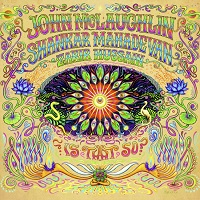 John McLaughlin/Shankar Mahadeven/Zakir Hussain
John McLaughlin/Shankar Mahadeven/Zakir HussainIs That So?
Abstract Logix
2020
Six-years in the making, the seeds for Is That So? were planted during Remember Shakti's short India tour of 2012—which also took in Ramallah, Palestine—when John McLaughlin first floated to vocalist Shankar Mahadeven the possibility of harmonizing essentially linear music. Mahadeven sent McLaughlin recordings of bhajans—Indian devotional songs—and little by little, McLaughlin harmonized guitar parts, or rather guitar transposed through sine waves, oscillators and filters—almost synthesizer-like in tone.
It was a painstakingly slow compositional process. Once completed, McLaughlin brought Hussain into the frame and improvised parts were then integrated. Hussain mostly plays the tablaist's traditional accompanying role, but revels in the personal freedom on "Sakhi." Yet for all the bursts of passion from guitarist and singer in particular, this is in essence a serene work of outstanding lyricism.
Mahadeven, who has never sounded better, ranges from whispering caress to soaring release. McLaughlin rates this album as one of the crowning achievements of his career, and it is hard to argue with that. Low key, perhaps, at least when compared to Shakti/Remember Shakti, but utterly sublime in its own right.
Tags
Building a Jazz Library
Zakir Hussain
Ian Patterson
john mclaughlin
Pharoah Sanders
Pat Martino
charles lloyd
Dave Holland
Chris Potter
Jan Garbarek
Ravi Shankar
The Grateful Dead
Mahavishnu Orchestra
Charles Mingus
Trilok Gurtu
archie shepp
Frank Zappa
Ginger Baker
Jerry Garcia
Babatunde Olatunji
Giovanni Hidalgo
Airto Moreira
Flora Purim
Tony Williams
Jack Bruce
Scott Thunes
George Brooks
Steve Smith
Kai Eckhardt
Fareed Haque
Eric Harland
John Coltrane
Anouar Brahem
John Surman
PREVIOUS / NEXT
Support All About Jazz
 All About Jazz has been a pillar of jazz since 1995, championing it as an art form and, more importantly, supporting the musicians who make it. Our enduring commitment has made "AAJ" one of the most culturally important websites of its kind, read by hundreds of thousands of fans, musicians and industry figures every month.
All About Jazz has been a pillar of jazz since 1995, championing it as an art form and, more importantly, supporting the musicians who make it. Our enduring commitment has made "AAJ" one of the most culturally important websites of its kind, read by hundreds of thousands of fans, musicians and industry figures every month.











